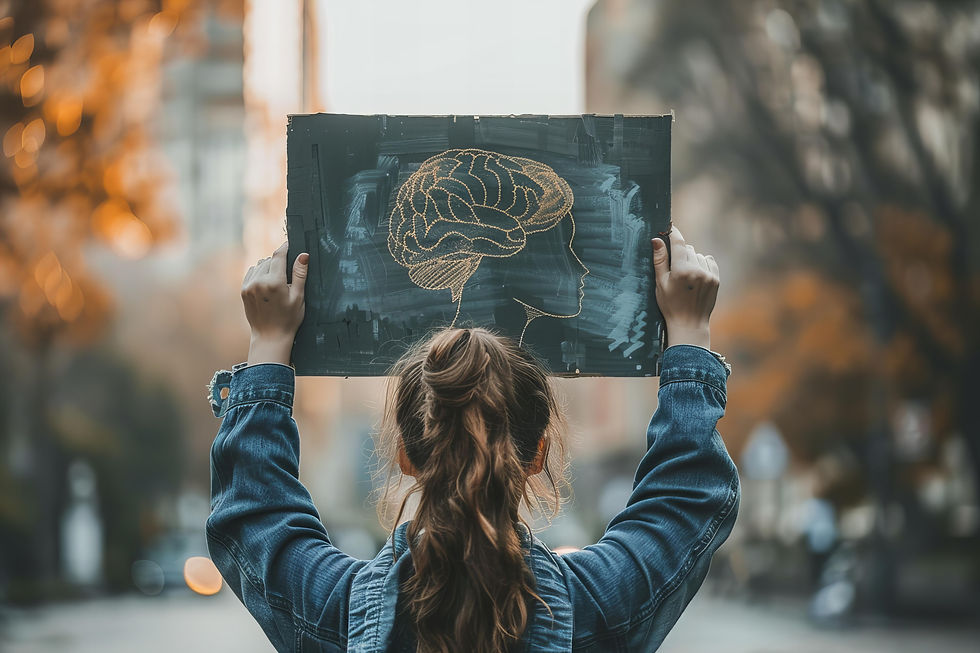Insights Into Loneliness and the Brain
- Dr. CK Bray

- Jul 27, 2023
- 4 min read

I was recently asked a question from one of my podcast listeners about loneliness. They wrote, “Dr. Bray, I feel lonely, yet I am surrounded by friends and family. What is causing this, and do you have any suggestions on how to overcome this feeling? It seems to be getting worse.”
You are not alone! Loneliness has become an important issue since Covid, and research shows individuals who are lonely is increasing.
The neuroscience and psychology of loneliness have provided fascinating insights into this pervasive issue, revealing its profound effects on our brain and mental health.
Loneliness is a familiar sensation to most of us, a sense of social isolation that can creep in, no matter how connected we might appear to be or even when we are around lots of other individuals. Loneliness isn’t just about being alone; it’s more about the quality of our social interactions than the quantity. I have been stunned when conducting interviews with individuals who expressed they feel lonely, but from my perception, they are very connected with others both in the workplace and in their personal lives. Yet they had a very different view.
The brain views loneliness in interesting ways, you could be in a crowd at a concert and feel completely lonely and isolated, yet you could be in the wilderness, very much alone, with solitude and yet feel peaceful and content. Neuroscience has begun to shed light on isolation, loneliness, and the brain. Loneliness ties into brain areas that are linked to social cognition and emotional regulation such as the prefrontal cortex and the amygdala. This absolutely makes sense because social integration and emotions run hand in hand with isolation.
Research using functional magnetic resonance imaging or FMRI found that lonely individuals showed more unique idiosyncratic brain processing patterns. These patterns can contribute to various mental health issues, including depression and anxiety. Loneliness can change the way we perceive the world around us and how we interact with it. The key word is perception! If we feel lonely, the brain can tend to focus on how and why we feel lonely. The brain will seek to confirm those emotions and feelings. If you see several co-workers leaving the office to eat lunch together, your brain may say, “See they left you out, you aren’t good friends, they don’t want to spend time out of the office with you. When in reality it may be that they aren’t going to lunch together but just ended up walking out of the office at the same time or they decided to go to lunch and looked for you, but you were in a meeting. We think we have all the information (your brain wants to believe that!) But we don’t.
It is important to know that loneliness and mental health share a deep connection. One feeds the other. Several studies have shown that loneliness can contribute to various mental health issues, including depression and anxiety. Moreover, chronic loneliness can lead to a persistent feeling of threat and hyper-vigilance for social threat, contributing to an array of negative health outcomes, including sleep disturbances, decreased immune function, and increased morbidity.
Research has suggested various ways to combat loneliness and its negative impact. Remember, everyone’s brain is different so what may work for you may not work for others. A few suggestions include:
Meditation can reduce feelings of loneliness. Even a single session!
Talking with a friend and sharing your feelings which are in turn reciprocated.
Participating in hobbies with others, those you share similar interests in. This can be a building bridge to growing that friendship beyond just the hobby.
Service to others. This is one of the best ways for you to engage with others and feel the meaning and purpose behind what you are doing. Serve others.
In our neighborhood, I am starting up a group small group of 10-15 men and women of all religions, races, and ages to be in a group that is a first responder to emergencies. If we have a big storm in Arizona and your trees are down, call the group, and we will be there to help! We meet twice a year, and our first project is going to be making sure everyone has enough water, a first aid kit, and a 72-hour kit. If something happens, they could survive for 72 hours. This small group, which doesn’t take up too much time, is helping our neighborhood and bringing people together!
If you want to learn more about any of the specifics talked about in this article, I have included the citations below.
LEARN MORE FROM THE PODCAST
CHECK OUT DR. BRAY'S NEWEST BOOK
CITATIONS
“Loneliness and social isolation as risk factors for coronary heart disease and stroke: systematic review and meta-analysis of longitudinal observational studies” by Nicole K Valtorta et al. Heart
“Loneliness matters: a theoretical and empirical review of consequences and mechanisms. Annals of Behavioral Medicine” by Louise C. Hawkley et al. Annals of Behavioral Medicine
“The growing problem of loneliness” by Cacioppo & Cacioppo. The Lancet
“Brain structure links loneliness to social perception” by Ryota Kanai et al. Current Biology
“The association between social relationships and depression: a systematic review” by Ziggi Ivan Santini et al. Journal of Affective Disorders
“The neuroendocrinology of social isolation” by John Cacioppo et al. Annual Review of Psychology
“Social media use and perceived social isolation among young adults in the US” by Brian A. Primack et al. American Journal of Preventative Medicine
“A meta-analysis of interventions to reduce loneliness” by Christopher M. Masi et al. Personality and Social Psychology Review
“Mindfulness training reduces loneliness and increases social contact in a randomized controlled trial” by Emily K. Lindsay et al. PNAS





Comments